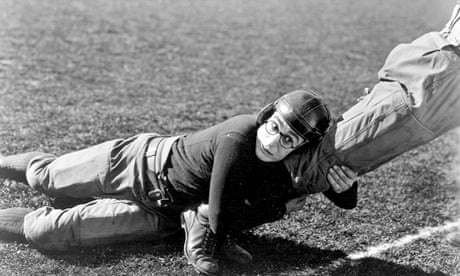Before the new Harold Lloyd film 'College Days' was shown in England a certain well-known critic, and probably a number of others, told the newspaper-reading world to go and see it, as "a new Lloyd film is as much of an event as a new Chaplin in the modern kinema," or words to that effect. True. So is a new Sinclair Lewis novel as much of an event as a new John portrait, or the passing of the Budget as much of an event as the winning of the Diamond Sculls.
This constant comparison between Chaplin and Harold Lloyd, this bracketing of their work in one breath as though it were work in exactly the same kind, has done no good to the players themselves. Disappointed followers of Chaplin, puzzled by it, have found Lloyd weak, sentimental; disappointed admirers of Lloyd have found Chaplin unromantic, crude, a little bit dry. As a matter of fact, the only maker of film "comedies" who can be considered in the same genus as Chaplin is Buster Keaton. Lloyd is as far removed from Chaplin as the sentimentalist Griffith himself.
Because Chaplin is immeasurably the finest artist the kinema has yet produced, there is no reason why other men should not be working in the same manner, along the same broad lines as he follows. Chaplin has brought improvised comedy to the screen, the commedia dell' arte of the camera. He stands within the barest framework of story and touches everything around him - hats, chairs, sausages - to comic purpose. He wears the mask of an individuality that is universal. Every Chaplin film is the same film: or rather, it is not a film at all, but another bit of the same Chaplin. In this way, too, Buster keaton, whom the French better call "Frigo" - the frozen-faced, - weaves comedy. He too wears a mask. He too stands within the barest story-framework and touches all around him to comic purpose. He too works from the head, not from the heart or the seat of the trousers. Quality, not kind, separates him from Chaplin himself.
Harold Lloyd is quite another matter. He is not a comic artist, although he stands with Chaplin and Buster Keaton in the first trio of the screen's laugh-makers, above and apart altogether from the custard pie pack. Each one of his films is a humorous drama built upon a framework of romance. And within this framework - a firm and well-defined framework, raised to a climax, rounded off - Harold Lloyd takes his place, waiting to be touched by everything around him to humorous purpose. In spite of his glasses, he wears no real mask of universality. He is a different Harold, with a different worry, in every film. He does not shape the plot; the plot shapes him. And between those sentimental partners, humour and pathos, dry comedy is kept away.
This is an edited extract, click to read on.

Comments (…)
Sign in or create your Guardian account to join the discussion